Justice, "Alakazam!"
Are you saved?
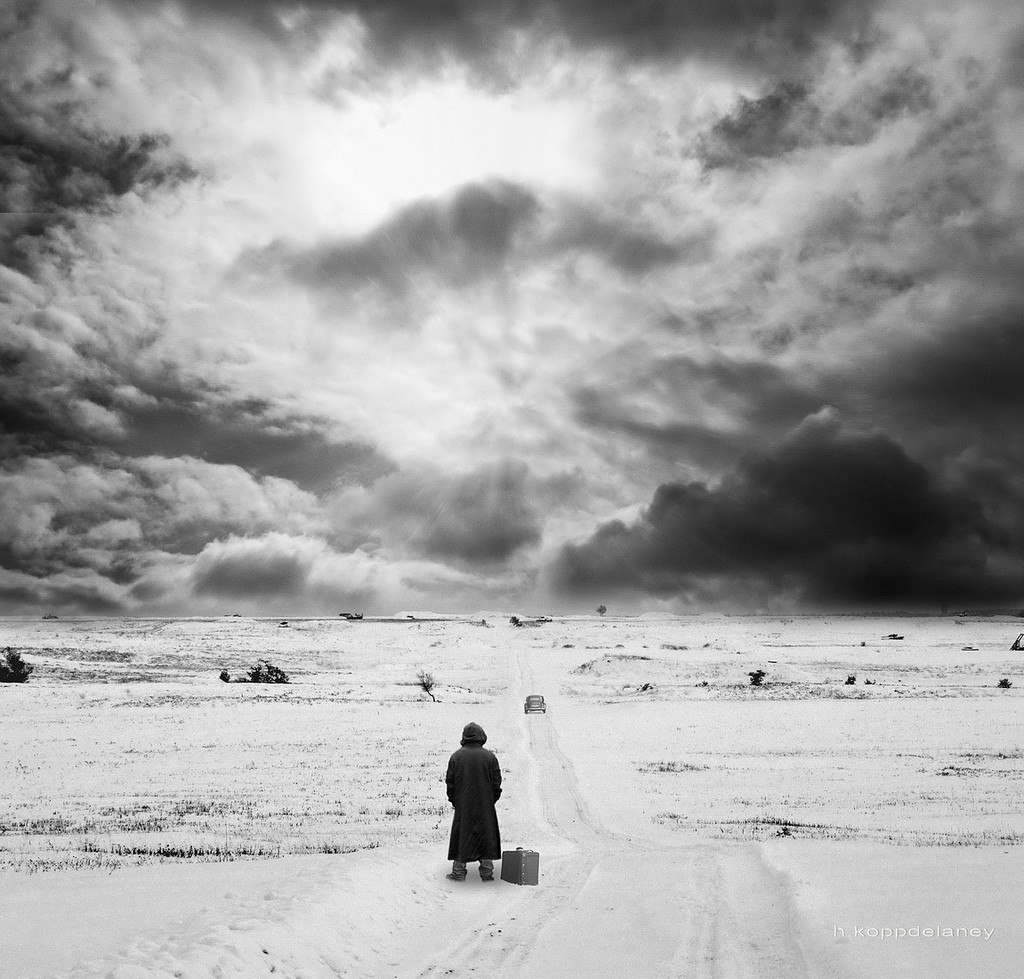
Is the Internet down for you this morning? Rejoice and count yourself among the elect, chosen by God or fate or sheer luck to be spared the unceasing barrage of outrage and offense the Internet pumps out at you every waking second of your life. If the Internet isn’t down for you, I’m sorry. This is the closest any of us will ever come to knowing what it feels like to be left behind in a Rapture-type situation. This hell in which we make our way each day will be even worse now that we know others have been freed from it. At least it’s Friday. Here’s some music. Enjoy.
New York City, October 19, 2016

★ Sun was in the limbs of the far side of the sycamore, so they shone in bright segments through the still-shaded nearer crown. The bank clock above the trees said 71 as parents fresh-scattered from the school dropoff reconverged on the subway. Drivers had their visors down heading crosstown into the glare. By midday the sky was a weak and non-autumnal blue. Leaves had kept falling in the hot light, through the hot air. The 1 train car with the broken air conditioning could not have been as sweltering as it would have been in August, but sweating stoically without changing cars was too stupid a thing to contemplate.
Things I Hope the Dracula Airbnb Contest Winner Does in His Castle
On Halloween, of course
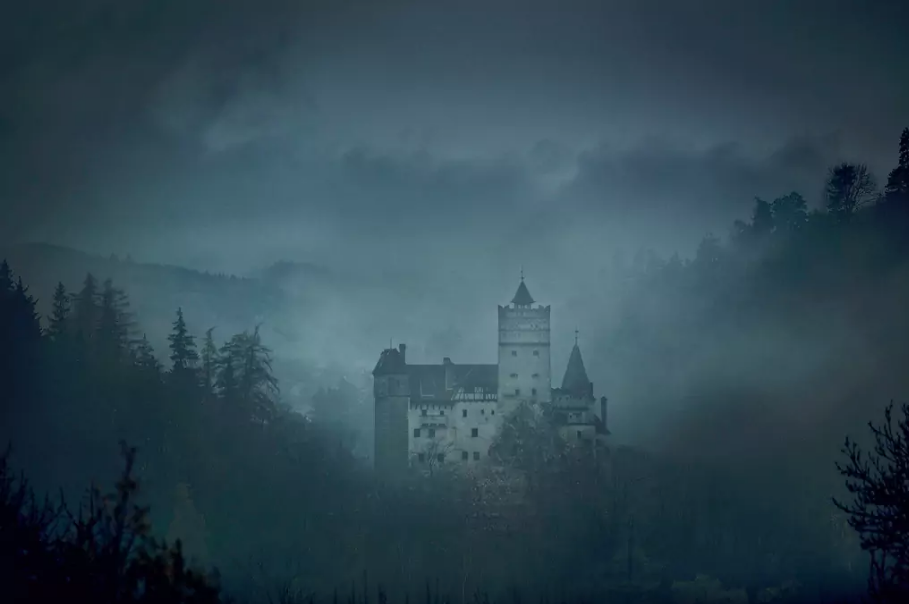
AirBnb is currently running a contest for a true fantasy vacation: an all-expenses-paid trip for two to Romania to stay in Dracula’s actual castle for Halloween, complete with a guided tour from Dracula author Bram Stoker’s great grandnephew Dacre Stoker.
I don’t mean to sext you in broad daylight, but please read their description of the experience:
A horse-drawn carriage carries you swiftly through Transylvania as the sun sets towards the horizon, heralding the hours of swooping bats and howling wolves. When you come around the final bend on the tree-lined road, you’ll catch a glimpse of Bran Castle. This misty mountain-top manor is home for the night…Dacre Stoker, Bram Stoker’s great grandnephew, will answer your knock on the castle’s imposing wooden doors. He will be your host for the night, and resident expert on Transylvanian lore. Enter the castle and explore the labyrinth of lamp-lit corridors, creepy nooks, and squeaky staircases while there is still light in the sky. You may traipse through all fifty-seven rooms, from lofty tower lookouts to deep dark crypts, and even enjoy an incomparable view of the Carpathians from the terrace as the sun makes its final descent. But once darkness comes, retreat inside. Unexpected guests have been known to come knocking in the moonlit hours.
A secret passage on the first floor leads to the grand dining room where an intimate candlelit dinner will await, prepared exactly as described in Bram Stoker’s novel. Following the hearty, blood-enriching meal, you will be left to sleep in luxurious velvet-trimmed coffins in the seclusion of the Count’s crypt.
Fall asleep to the creaks and whispers of the Transylvanian night, and the sound of wolves roaming outside the castle walls.
Horny yet? I know I am.
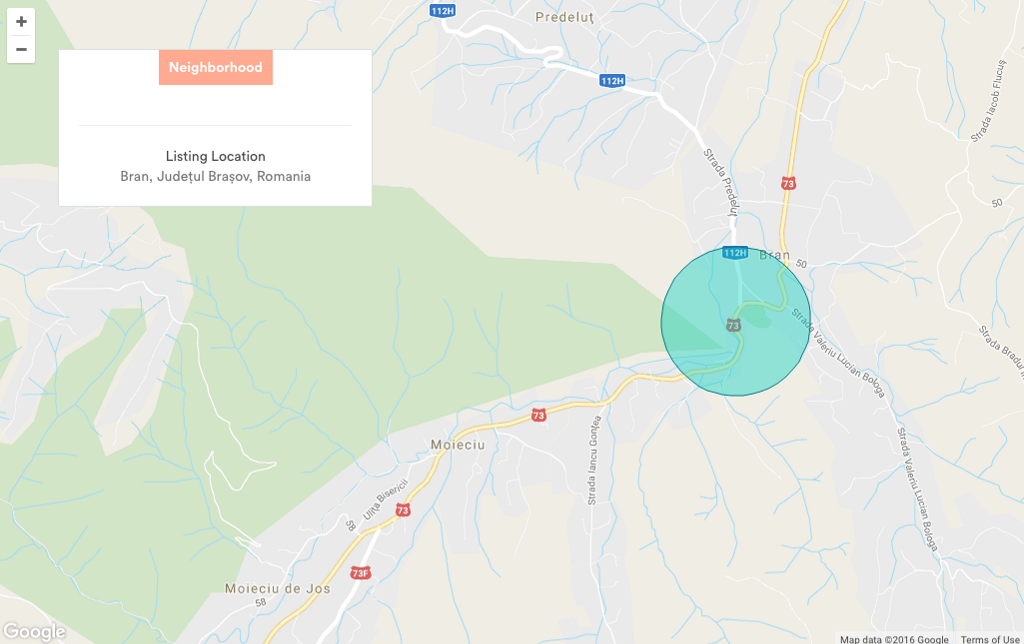
I also know I won’t be entering or winning this contest (you have to write and submit something), but, to the person who does, I think the winner owes us the following:
- A loud cackle from the top of a staircase.
- Peer out from behind a slowly-opening, creaky door to say something like, “Ready for dinner?”
- Be the eyes of a painting.
- Run down a long, stone-floored hallway so the sounds of your footsteps echo off the high ceiling.
- Stop mid-run to listen for the echoes of a second set of footsteps. Ghost footsteps.
- Walk somewhere cautiously while holding a candelabra.
- Ask if there’s blood in the wine.
- Ask if there’s garlic in the food.
- Bring a spare battery and charge it while you’re there. Don’t use it till you’re home. Your phone’s running on haunted electricity, dog.
- Sleep in the coffin they provide for you.
- Hold hands with your guest while you are each lying in your respective coffins and make Dacre take a pic of it.
- Open a window at night and howl like a wolf. See if any wolf buds reply.
- Point at a bat in the sky and say, “How beautiful!!!!”
- Climb to the top of the tower at the stroke of midnight.
- Ask Dacre if he’s dead.
- Ask Dacre if he’s a vampire.
- Ask Dacre if his great-granduncle was a vampire.
- Ask Dacre what percentage of the Romanian population identify as vampires.
- Ask Dacre how to say, “Are you a vampire?” in Romanian.
- Abruptly close a velvet curtain.
And to the winner: thank you in advance for complying.
What's Spookier Than Saint-Saëns's 'Danse Macabre'?
Classical Music Hour with Fran
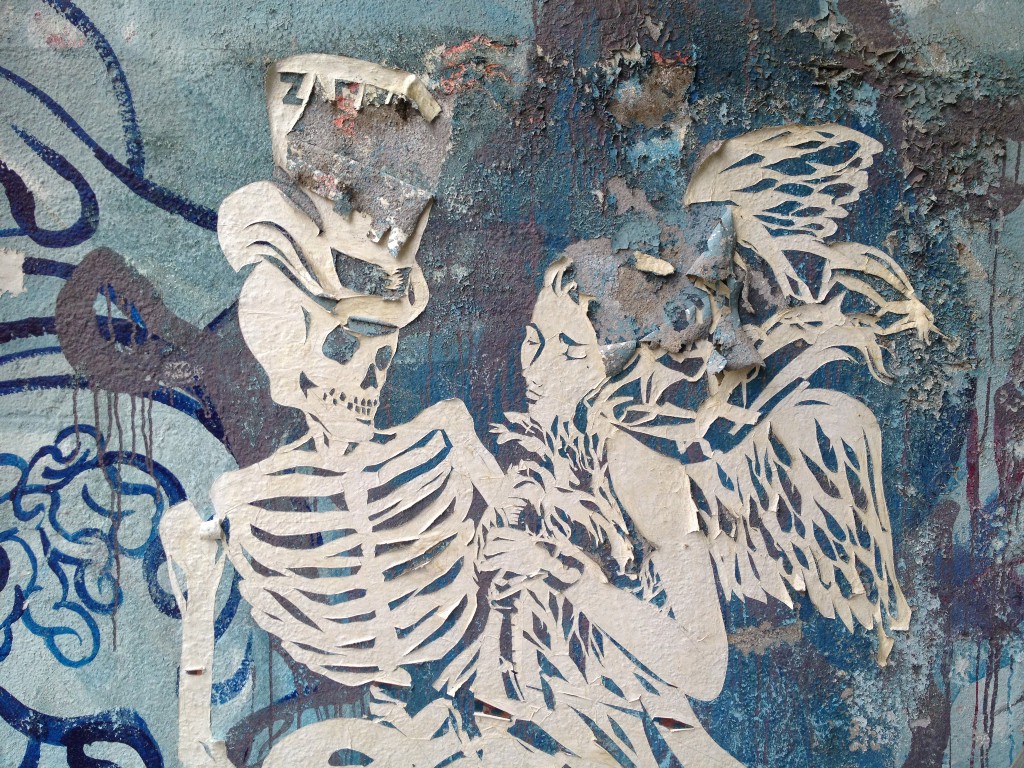
Hello, Happy Thursday. Both an old Walgreens and an old Sports Authority in my neighborhood as well as an empty storefront next to a Walgreens near my work have transformed into HALLOWEEN SUPERSTORES. Halloween is extremely upon us, and this week I am bringing you the first of two spooky pieces of music: Camille Saint-Saëns’s Danse macabre in G minor, Op. 40.
Charles-Camille Saint-Saëns (to those asking: yes, it is a power move to have a hyphenated first and last name) was a French composer in the latter half of the nineteenth century. A contemporary of Dvořák, Brahms, and Tchaikovsky, Saint-Saëns was considered a deeply traditional composer. His work is rooted much more in the classical and romantic music that came before him and far less in impressionism and the modern classical music that took over the late nineteenth and early twentieth century. In fact, he walked out of the premiere of The Rite Of Spring in 1913 (which, okay, in fairness, this premiere led to one of the most notable classical music riots in history in which many audience members stormed out if not full on fought each other). Either way, I can’t stop laughing at this. It’s a very French thing to have done. He is often regarded as one of the most important French composers of all-time, and he’s certainly one of my favorite. There are a lot of weird and wild anecdotes about C-C S-S (this is the only time I will refer to him as such), many of which I will save for future columns.
As I started to research Danse macabre, I found myself down one of the better Wikipedia rabbit holes:
Saint-Saëns → Danse macabre → Dance of Death → The Devil in classical music (!!!!!!!) → Tritones
Did you know that tritones signify the Devil and Satan and evil spirits in music and that everyone just used to “know this” and “recognize this” and if you heard it in a piece you’d be like, “oh, right, the Devil”? You know this now, so when you listen to the start of Danse Macabre, you too will be able to say, “oh, right, the Devil.”
Danse Macabre is considered a tone poem, which is to say it tells a story or a fable through the music itself. Different instruments represent different characters — the violin is the Devil, the oboe is a crow, the xylophone is rattling bones. Danse Macabre is based on an old medieval allegory about the “dance of death” which was essentially a “dance” that everyone knew because everyone was going to die one day.
For something meant to be so audibly spooky, it’s also genuinely very campy. I mean, let’s be real: anything older than It Follows feels campy when it comes to horror. I mean, read the source text for Danse Macabre:
Zig, zig, zig, each one is frisking,
You can hear the cracking of the bones of the dancers.
A lustful couple sits on the moss
So as to taste long lost delights.
Zig zig, zig, Death continues
The unending scraping on his instrument.
A veil has fallen! The dancer is naked.
Her partner grasps her amorously.
Omg!!
As a percussionist, I’ve always been particularly drawn to pieces that use percussion outside of timpani. It’s not to say timpani are bad — they’re actually extremely cool and good — but using a variety of percussion instruments is a very modern thing to do. Danse Macabre has a whole bunch of percussion in it. Timpani, sure, but also bass drum, cymbals, triangle, and xylophone. A great fact: this is the first piece of Western classical music to use the xylophone. I love that. It’s a very good use of the xylophone. The xylophone is one of the coolest instruments of all time, second only to maybe the cello which is both big and graceful (see also: me).
Anyway, cue this piece up as you enter any HALLOWEEN SUPERSTORES and let the devil’s dance remind you that one day we’ll all be jaunty, horny skeletons dancing to Saint-Saëns in Hell!
Fran Hoepfner is a writer who used to be a musician, but not in an acoustic guitar sense, more in the the movie Whiplash sense. As kids her age discovered the popular music of the early ’00s , Fran spent 10–15 hours a week in private lessons for piano or playing timpani in several Chicagoland youth symphonies. Because of that, she didn’t discover pop music until 2008, and now her music library is almost exclusively classical. You should listen to more classical music, not for any self-important reason, but just because it’s more accessible than you think it is. Also it’s very good.
How To Cook A Turkey In August
Think you’re bored of Thanksgiving? Imagine being a food writer.
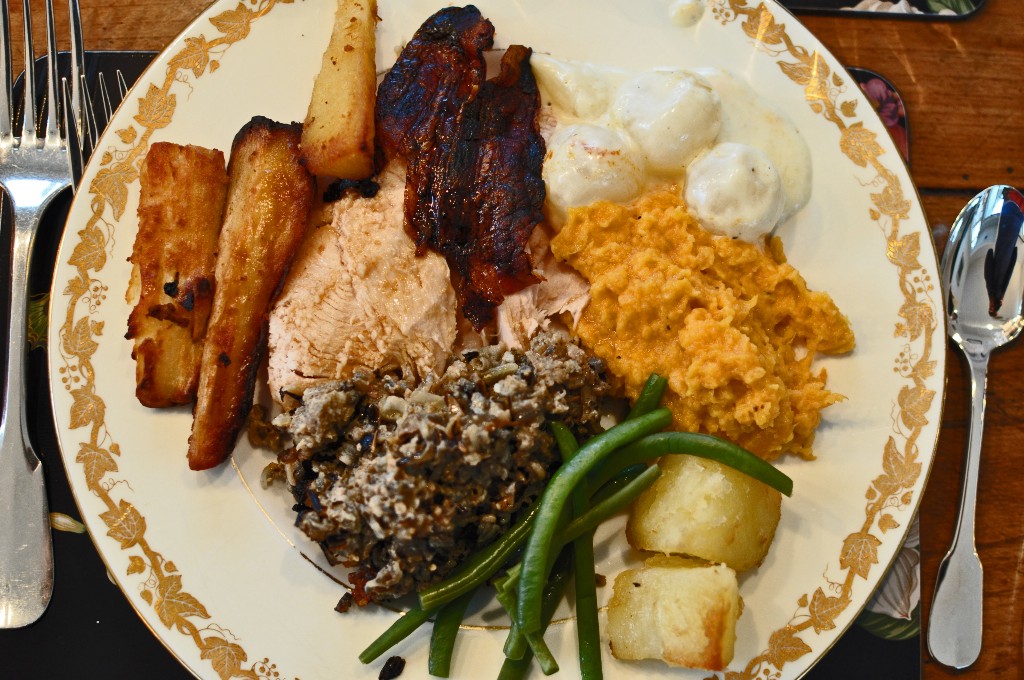
Thanksgiving beckons! Or does it loom? Either way, it’s coming soon, just around a corner or two. And whether it’s is an annual high- or low-light for you, Thanksgiving is a death-and-taxes truth, as certain as Halloween endcaps in August and Valentine’s Day cards out on New Year’s Day. The early warning system for Thanksgiving, however, is the flood of themed issues of monthly magazines and pumpkin spice-templated food websites, which start hitting the mailboxes/grocery checkout racks/tabs around the Ides of October.
Of course, not everyone looks forward to Thanksgiving (like, say, the non-U.S. portions of the planet), and not everyone participates in this annual content rollout. For retail employees it could be well the day that one has to clock in at four thirty in the morning so that the paid-day-offs can come and riot over a doorbuster Blu-ray player. For others, the dread starts well before, when others are apple-picking or pulling the A/C units out of their windows. But it must really be the worst for people who write about food for a living. Somehow, enough Americans to power a sector of the food and beverage content industry to keep this charade going. They flip through the mags and wonder: Is this the year to try a Mexican-themed menu? Should we maybe slaughter the bird ourselves? How can I get the can-shape in a fresh cranberry dressing? Maybe chestnuts? Each year, they ask, What exactly is the right way to cook a turkey?
A 2006 issue of gone-but-not-forgotten Gourmet suggests both a simple roast turkey or, for a more intimate po-mo experience, a turkey roulade with cider sauce, while a 2008 issue offers the dilemma of either an Adobo Turkey with Red Chile Gravy or an Extra-Moist Turkey with Pan Gravy. Last year’s Food & Wine ran three different Juicy Turkey Recipes (all basted through cheesecloth) and a fly-on-the-wall view of perennial television food host/guest Tyler Florence’s first Thanksgiving at home. Meanwhile, Bon Appétit had a Glazed and Lacquered bird on the cover, with a Barbeque Spice-Brined Grilled Turkey and a Porchetta-Style Roast Turkey Breast inside. To be really completist about it, a still Chris be-Kimballed Cook’s Illustrated in 2011 concedes that roast turkey is the norm, but might you try the only, test-kitchen-proven way to make an Oven-Braised Turkey?
It’s a queasy number of turkey recipes, even from an incomplete and tiny sample size. But imagine if your job was turkey recipes? Imagine if, once a year, when it’s still hot enough to go to the beach on the weekends, turkeys were the wheel you had to reinvent? Can you imagine how fucking much you would fucking hate fucking turkeys?

This is admittedly an issue of parochial interest. Maybe we are more ready to delve into what it’s like to pretend to be someone else for money, than we are to wonder what it’s like to try to make sense of a biological imperative that’s been elevated into elaborate rituals and customs that differentiate groups of people on the planet. Or maybe not! Thanksgiving is actually important, here in these United States.
Every kindergartener knows Thanksgiving was set into motion by a bunch of apostate Protestants who didn’t think the Church of England was sufficiently churchy enough. They risked life and limb to transit the North Atlantic wearing scratchy wool clothes, met some friendly Indians (as they were blithely called at the time) who taught them how to make creamed corn and so they all had a big annual party to thank each other, themselves, the Creator, etc. It looks good when Norman Rockwell paints it, but the story is a little more complex, if not kind of wrong. The Pilgrims left from Holland, not England! Thanksgiving Day as we know it was not invoked until 1863, during the Civil War, by President Lincoln, and did not achieve banks-closed status until 1941 when President Roosevelt signed a bill making it so (also during a war, oddly enough). The holiday was intended as a day of literal giving-of-thanks from the beginning, but leadership felt a little more inspired to pursue this during times of strife, for whatever mostly transparent political reason.
It’s also a harvest holiday based on timing: back before food production was globalized and industrialized and refrigerated and test-tubified, the waning days of fall were when the last of such food was gathered and stored so why not cook up some perishables for one light moment before a long winter of eating roots? All together, Thanksgiving is a sui generis conglomerate of non-pilgrim related causes, which has been noted all over the place but nicely summed up by Co.Design:
Ultimately, you have all of these discrete forces coming together to form Thanksgiving that were unique to a 19th-century America — a need for revisionist history, an earnest quest for new tradition, the migration of New Englanders across the country, a hope for an end to civil war, and a cold weather holiday before the era of Christmas.
This secular holiday has somehow united the country through food (and televised football and shopping) in a way that none of the religious/nationalistic/greeting-card-industry holidays ever has.
Christmas is obviously important to commercial interest, giving that it is the holiday of purchasing things and giving them to third parties, in the food and beverage business, Thanksgiving is the kick-off of that season, falling conveniently in Q4. As TakePart food editor Willy Blackmore explained, “There is a whole industry built around supplying birds for Thanksgiving.” According to the National Turkey Federation, a little less than a quarter of all turkeys eaten in the U.S. are served on Thanksgiving Day, and according to Nielsen, when it comes to whole turkeys, that percentage is more than three-quarters. It’s not just poultry that sees a bounce for Thanksgiving — it is (again according to Nielsen) the biggest time of year for both cranberries and sweet potatoes. The week of Thanksgiving is second only to the week of Christmas for food and beverage consumption.
Indeed, Thanksgiving is not illogically a red-letter day for the food-and-beverage-content industry — aside from construction-paper historicities with Pilgrims and smiling indigenous peoples sharing a traced-hand turkey, it is a federal holiday entirely glued together by food. “It’s an eight-hour day of cooking, the marathon meal,” said Blackmore. Sure, a five-and-dime foodie will be thumbing through Lucky Peach at any given time, but for the vast majority of Americans who have other more pressing concerns, Thanksgiving is the day that even they might rip a page out of the Parade insert in the Sunday paper, or start punishing Google with BEST GRAVY RECIPE searches.
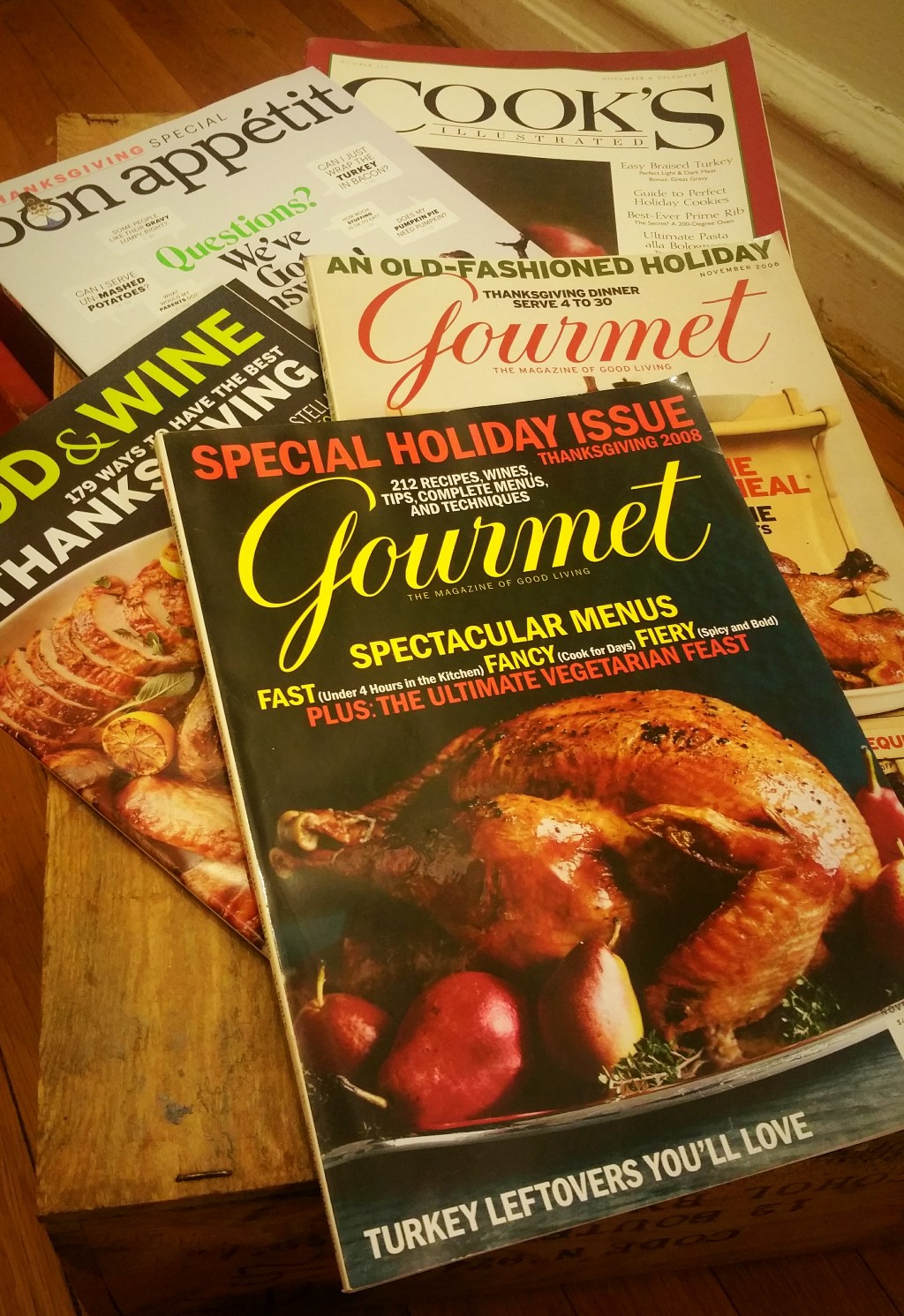
This interest is good for content creators — content can be tailored to it — and it’s really good for the those in the business of making money off this content (if, say, the venture is wholly/partially advertiser supported), because it’s a peg. You probably can’t tell the local Buick dealership that a pipe bomb will go off next week and that will boost newspaper circulation, but you very much can tell the Buick dealership that President’s Day is coming, and your ad department will happily photoshop Abe Lincoln in sunglasses riding in a 2017 Buick Lacrosse.
“It’s a good time to get people to throw money at a publication,” Blackmore said, and, the bottom line being the bottom line and all, it is a good thing for the publication to have money so thrown. And so the front-of-book piece on whether the third S in Brussels sprouts should be disappeared is assigned, written and published.

For some in the food-content profession, Thanksgiving is more like Groundhog Day (the movie and not the fake holiday) but with turkey instead of a rodent. In 2009, Regina Schrambling wrote for Slate about how food writers hate Thanksgiving. “Not the day, not the food, not the cooking or the shopping,” she qualifies, but rather the hands-on aspect of taking the holiday and the consumer interest therein and converting that into copy, recipes and photos that will bump circulation:
What makes me totally crazy is the persistent pressure to reinvent a wheel that has been going around quite nicely for more than 200 years. Every fall, writers and editors have to knock themselves out to come up with a gimmick — fast turkey, slow turkey, brined turkey, unbrined turkey — when the meal essentially has to stay the same. It’s like redrawing the Kama Sutra when readers really only care about the missionary position.
Your personal Thanksgiving may or may not resemble that last bit (as much as your uncooked turkey does), but the point stands. And in addition to the forced annual revisit and deeper-than-average scrutiny afforded, the lead time for good old-fashioned print publishing, is cognitive dissonance on a stick. For some magazines, the lead time can be as long as three months, with spitballing and recipe testing starting in August, and the food we eat on Thanksgiving Day is food that is good and appropriate to eat in the waning days of Autumn, and not so much in the full swelter of the summer. The week before Labor Day, one might want a slice of refreshing key lime pie, not a gooey wedge of sour cream apple, or really anything that contains and/or resembles mince meat.
The process of devising a recipe, in between conception and transcription, is cooking something over and over, in an actual kitchen, and when it’s a muggy ninety-five degrees out, a tester can be forgiven for wishing there was such a thing as Thanksgiving Ceviche. Sophie Brickman, the features editor at Saveur, said, “It’s a surreal thing to walk into work and smell Thanksgiving every August, but every year you have to come up with a new way to cover it.”
One writer I spoke with confided that the Thanksgiving issue was actually the last straw — her reason for leaving a staff position for good after an ideas meeting for the months-hence Thanksgiving issue. “It was a specific meeting. It was like, if we have to talk about how we’re going to reinvent a turkey one more time…? Because I think that I already have a great turkey recipe. I use it every year!”
Let’s take for granted that writing, for “exposure” or for money, is easier to romanticize and to treat like a calling or holy work — a divine prerogative to conjure ether into a different kind of ether! There is a self-proclaimed exaltation that is rarely invoked in, say, HVAC maintenance and repair. Food writers, man, they sure have it easy, getting paid to cook and eat! (Although the industry is slowly dying and the formerly remunerative staff positions are being eaten from the inside by digital, of course.) But at the end of the day, it’s still a job, and as such, grounds for griping.
As the writer who left after the ideas meeting told me, “I have no more ideas. I have no more thoughts. I have no more joy left for this holiday.” I think we’ve all had days we’ve felt similar, and not a thing wrong with that. Sometimes you hate Mondays, and sometimes you hate the last Thursday in November.

The first time I asked anyone in the know about this was actually not recently at all and purely out of curiosity. I was chatting with an old pal with ample experience editing publications devoted to food/cooking/dining etc. over dinner, I asked, “So hey, is it sort of a grind having to put your Thanksgiving hat on every August forever and ever?” And the answer was, “Oh yes, ugh, OMG I very much dislike that part of the process, yes.” A paraphrase, of course, but the impression given was that the Thanksgiving issue and the preparations therefor was a well-known drag.
But as I started to talk to other food media professionals, I noticed that the disdain for this particular flavor of food journalism was not exactly universally held, and when held, not always enthusiastically so. Then I talked via email with Jane Lear, another veteran of the food mag business and executive editor of upcoming print mag CURED. She wrote:
After more than 30 years in this business (including almost 20 years at Gourmet), I can say that Thanksgiving is never far from the mind of a professional food writer or editor. And you would think that over the course of Gourmet’s 68-year history, we would have it down cold, and be bored to death of the same-old, same-old. But, in fact, that couldn’t be further from the truth. The cooks there took absolutely nothing for granted, and were always on the prowl for new and better ways to cook a traditional Thanksgiving feast or, on this, the most inclusive of holidays, provide centerpiece-worthy vegetarian or vegan alternatives.
Possibly that could qualify as a “yes, but,” but then again, as Brickman says, “You still have to cover it.” Thanksgiving may be a very unique meal in a year of 365 menus, but it’s still a meal, and if the job/calling is to report and talk about the things we eat and the ways we cook and eat them, Thanksgiving counts.
I spoke with Sam Sifton, food editor for the New York Times and the author of the book on Thanksgiving (titled Thanksgiving: How To Cook It Well), and Sifton remains an unabashed fan of producing coverage of the holiday, and the holiday itself. “Either you’re into the holiday, or you’re not into the holiday, and I completely understand that there are those who do not relish the thought of having to come up with a new way to celebrate it in the world of food media.” Sifton is not an advocate of catching trends by the tail and shoving them into a Thanksgiving dinner-sized box. “What you really need to do if you’re going to write about Thanksgiving in a fresh way every year is to find ways new to you, new to your readers traditions, that are deeply held by someone else.” Sifton also confirmed he does not believe that Thanksgiving is a repetitive-motion injury for a food writer: “I relish the chance to find out something new about it every year.”
Not to get all Rashomon about it, but big secular food holiday can be a big deal to those involved up to their elbows both in a kind of lousy way and in a big aspirational climb-every-mountain way. This is also the case for service journalism in general, which is also the case for slinging burritos for a fast-casual chain, which is the case for a job. Unless you are so lucky as to devise something as world-saving as a ride-sharing app, a job is the thing you do for money and any personal satisfaction derived therefrom is a purely subjective matter.
Six years after Schrambling’s short essay went to digital press, Drew Magary, then of the website/McGuffin known as “Gawker,” noted the piece and declaimed, “Food writers are shit.” It was a slow news day I guess, but the backlash is always there, if you ask for it. And if you ask for the converse, then, well, the busman’s holiday is still a holiday, so here have the world’s tiniest violin.
The holiday itself is worth writing about: is it a cynically exploited moment of nationalistic groupthink or just an artifact of our collective innocence? Thanksgiving Day is a reality for great swaths of America for people of all types and situations and circumstances and political orientation. “It is our nation’s biggest secular holiday,” Sifton said, “and the chance to make those meals better through our reporting and the services we provide is pretty fun.”
Maybe the griping about Thanksgiving coverage — overkill, backlash, backlash-to-the-backlash — is blown out of proportion by jerks like me who take what would otherwise be a robust Slack thread and rip it out of context for the hopeful edification of the reading public. Maybe the hopeful edification was the point in the first place. Either way, it’s the middle of October. You’re about to learn the best way to roast a turkey again, just like you will next year.
A Case for Not Being Scared of Clowns
Some ideas for defusing the tension

This week, Target announced that they’re pulling clown costumes from shelves after a rash of “creepy clown” sightings nationwide had the meme-hungry media all hot and bothered. This isn’t my favorite genre of story. I’d largely foregone the articles and specifics of the situation, but would’ve described myself as “generally aware” of America’s current clown situation if you’d asked me.
But then I saw this Twitter poll from Rochester-area ABC News affiliate WHAM:
Target says it won’t sell clown Halloween costumes due to recent clown scares. How do you feel about clowns?
— @13wham
34% scared sounds about right, but 50% of people are out here prepared to be afraid of clowns on a case-by-case basis?! Everyone’s entitled to their phobias, and I acknowledge that in certain cases you can’t help what you hate, but I also feel very strongly that clowns are deeply dumb and there is no reason to assign them enough power to be scary. People dress up for all kinds of jobs—why does this one freak people out so much?
When I ask myself, “How am I not scared of clowns?” I can come up with a couple answers, and I’d like to share them with you now in the event that it calms some of your own fears.
Reasons clowns are not powerful totems of evil:
- Clown is too funny a word. Especially when delivered in anger or disgust. “Get a load of these clowns.” Try it. “Clown.” Dumb.
- Clowns are bad drag queens. Maybe you are a RuPaul’s Drag Race viewer and will be comforted to observe the intricacies of the paint job and ill-fitting polyfiber your everyday clown throws together for work. If you’re looking at a clown and starting to feel a little shaky, take a peek at the stitching on their satin unisuit. That’s some Party City shit. Did you peep their wig line and neck for good makeup blending? Cause you won’t find it. Most clowns I’ve seen don’t give a fuck about craftsmanship. How’re they gonna execute an elaborate murder plan if they can’t execute a casual Tuesday contour?
- [Extremely Chandler Bing voice] Who is a clown? Depictions of clowns tend to be old white men (which, granted, is the murderiest demographic), but when I think about who might get joy out of dressing up like a cartoon for others, I often picture someone with some pain. Someone who is maybe trying to counteract feelings about their own life by bringing joy to people who are currently children*. These are broad brushstrokes, but it’s nice to consider. A person who’s willing to look ridiculous so they can possibly bring a bright moment to someone else’s day is, while maybe not your cup of tea, probably a sweet lil shelter dog in certain capacities. And it’s hard to be scared of that.
Anyway, who knows? Phobias are real and so are clowns. I’m not your doctor. But I feel like reminding yourself that this is a person—looking for those signs that this is someone who has cultivated an image and not some freak Pokémon who just looks this way—is a strong place to start in defusing some of the tension.
Bring on the clown sightings, tbh. Clown pride.
_______
*Or maybe we are in a movie and this clown once had a little boy, and the little boy died of leukemia, and the only thing that brought the little boy joy during his time in the hospital was a clown who would come and visit the children’s ward. So after his son’s death, the father quits his job as a cubicle man and becomes someone else’s clown. Damn. Call me, Hollywood.
A Poem by Liz Colville
Canopy
I’m waiting to be seen
inside of a book,
a divine waiting room.
A new place crushes under me,
the kind an animal only runs through
when it’s being chased, limbs built
without assistance, and content.
I had wanted to get
where I was going. Fell down,
kind of laid there. No one
passed. Thought I was a castle.
Came to
with unmoving legs, shook them
awake. Walked back to a place
I didn’t know you and found I still
know you. Hearing other voices
got me out. But I’ve heard yours
for so long, a massive quiet
blanketed interference
with my dream of knowing no one.
I should have known
that these birds
were not conversing, they were
arguing about a tree. The tree
just waited. Take away words
and there are trees and species
still arguing, the lesser goldfinch
and the Steller’s jay,
arranging and rearranging
oral tradition. The finches
sit in near-silence until the light
starts passing behind
the lip of the sea.
Realize then
the argument is an intricate
goodnight to the sun.
You have to stay
in one place awhile to know that.
What a luxury to not move. I sat
in the dark and thought about
your own stillness
and what I’ve learned as the sanctity
above all else
of shared experience. It’s sheltering,
but I want to say, as if to warn you
about the weather, it’s not
the same as being known,
unless you know
something I don’t, like
that your repetition in the dark makes
the darkness lighter.
Know there is something living
above you in the canopy,
it just doesn’t
speak or sing, and it never worries
about whether
it will ever totally work
between man and the world.
Liz Colville’s poems have appeared in Lungfull! and Abe’s Penny, and she released a book of short fiction, Cover Story, in 2012. She was the founding writer at The Hairpin.
The Poetry Section is edited by Mark Bibbins.
Devonwho, "Andthentherewas"
Three nightmares down, one nightmare to go

A woman with whom I was talking about the election a couple of weeks ago got quiet for a moment and then, as if she had been visited by some powerful realization, declared that, “When Hillary wins it’s going to feel like I finally got my period after worrying about being pregnant.” I cannot offer anything more appropriate to the moment than that, but we should at least stop to acknowledge that today we are further away from another presidential debate then we will be at any point in the next four years. Even if you are someone who does not expect to be alive in 2020 this is still something worth expressing relief, and maybe even victory, over. I’m very proud of you for getting through it. Here’s some music that I hope you enjoy.
Today's Lies Will Come True Tomorrow
The future will be terrible because of what they’re telling you about the present.

Yesterday Digiday had an interview with Pat Keane, president of native ad inseminator Sharethrough, in which Keane declared, “Every publisher, if they don’t have a sound, scalable video strategy will die… You have to have broadcast-level investment oftentimes to be successful.” My first thought was, “Ugh, this shit again.” My second thought was, “Ugh, he’s probably right.”
Look, even though we know that readers and writers don’t want video — anyone who is interested in conveying or understanding information would much rather use a medium in which they are able to control the pace at which they process that information, and there has not been anything yet invented which does that better than the written word — we also know it doesn’t make a difference, because they are going to tell us that video is the future, so video is what we are going to get. (Why is video the future? You can charge more for it. Why do people lie? For money.)
Here’s a piece from Fortune today.
[L]ately budding entrepreneurs in the consumer packaged-goods — CPG, as it’s known — business have discovered an even better one to be in: technology. Positioning your toothbrush company as a hot, new, high-growth tech startup means more investment (from venture capital firms), a higher valuation, and — most important — all the tech hype and glory that come with the sweet startup life. Private equity firms usually want to double their money for a nice, solid return. But venture firms want to centuple theirs to become filthy, stinking rich. (Bonus points if you “make the world a better place” in the process.) Who cares if a company’s product has no technological component? Plenty of startups peddle the line that selling their goods over the Internet — basic e-commerce, in other words — means they are “tech-enabled.”
“Disingenuous, maybe. But it’s a winning strategy,” notes Fortune’s Erin Griffiths. Which is to say these lies will continue to be lied so long as they can be gotten away with, and as long as they are needed to be told to establish facts on the ground. Now, sure, in the scheme of things “the future is video,” “we’re a tech company” or “those numbers don’t reflect our full reach because so much of our content is consumed directly on social media,” are less immediately dangerous than “global warming is fake,” “the election is rigged” or “I won’t come in your mouth,” but they do two things that are just as damaging in the long run: They help make the world demonstrably dumber by diminishing our ability to understand it, and they cause us to be more cynical and self-interested as a defense mechanism for coping with all the lies. In the end even those of us who go on and on about how everything is lies will be too tired to argue about it anymore and just give in and watch the video. You can’t fight the future, especially when there’s so much cash riding on it.
New York City, October 18, 2016

★ The mild air was subtly suffocating, with its glowing burden of haze. The Broadway Line platform at Times Square was well on the way to recovering its summer thickness. It was iced coffee time again. Some people had gone back to bare shoulders, or even patchwork madras. Windows were dull in the glary light. Hair clung to the face. The heat subsided with sundown, but the relative chill was the chill of a dampened shirt. The west was nearly every color but not much of any of them.
